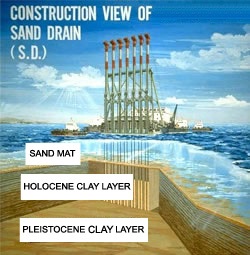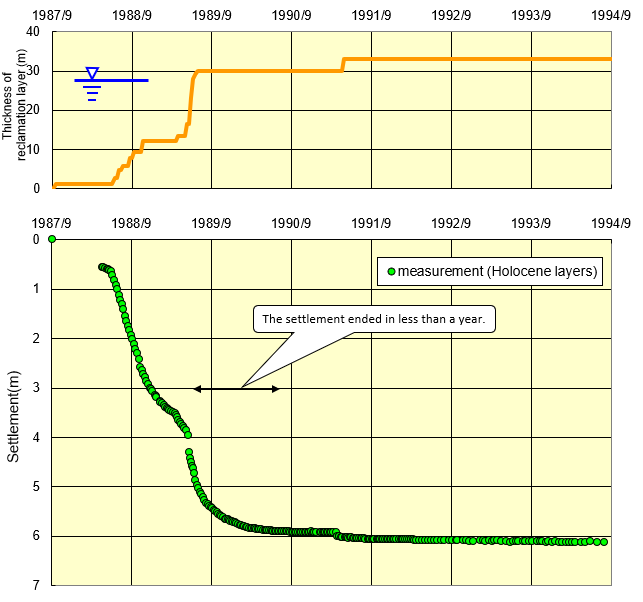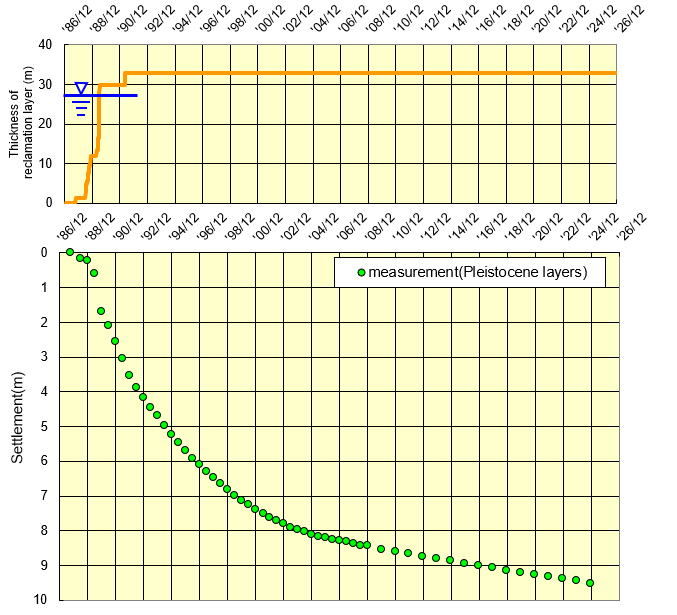
[KIX]
Condition of the settlement
Characteristics of the Settlement of the Holocene Layer and Ground Modification
The soft Holocene clay layer in the upper layers of the seabed is made from the same type of clay that can be found at the seashore. Technical measures to combat the settlement of this Holocene clay layer have been in process for many years. As a result, we have extensive knowledge and experience in the specificities of the settlement on the area.
The Holocene clay layer under the Kansai International Airport settles and decreases to two thirds of its original thickness. Additionally, the distance between the surface of the top layer and the sea level is small, so uneven spots on the surface of the top layer would likely have adverse effects on the airport facilities. Therefore, it was essential to modify the composition of the seabed soil.

<Mechanism of the Sand Drain Method>

<Mechanism of the Sand Drain Method Work Barge
for the Sand Drain>
The Sand Drain method consists on driving sand drains into the clay layer to let the water out of the clay layer as fast as possible. The method speeds up the settlement process and hardens the clay layer. We installed a million sand drains (20 m long and 40 cm in diameter) at 2.5 m-intervals into the clay layer under the main island and 1.2 million sand drains under the second island.
For construction scale purposes: The sand drain method was first used in Japan in 1952, and in the 35 years from then until the KIX construction, the total number of sand drains installed in Japan had only been 900 000.
The Holocene clay layer settlement data that we had been collecting for the first island since the reclamation began shows that settlement process ended in less than a year the artificial settlement process began. The KIX reclamation land has sunk very little since the alluvial settlement ended.

<An example of Settlement of Holocene Layer (Island 1 measurement point 17)>
Characteristics of Settlement of the Pleistocene Layer
The settlement of the Holocene clay layer ended during the construction of Kansai International Airport. Currently, the long-lasting settlement under the KIX islands is taking place in the Pleistocene layer.
The Pleistocene clay layer is so thick and solid that no soil modification is possible such as the one done to the Holocene clay layer. In this case, the Pleistocene layer sinks slowly and naturally over a long time.
The settlement data of the Pleistocene clay layer, collected since construction started on the first island, shows that filling the sea does not have significant effect on the Pleistocene clay layer, as the weight of the island does not exceed the load-bearing capacity of the layer (buoyancy decreases the weight of sand). However, settlement occurs once the artificial island emerges from the water and is now occurring slowly.

<An example of Settlement of Pleistocene Layer (Island 1 measurement point 17)>
Settlement of the Ground Surface of the Kansai International Airport
We have been observing settlement processes at 17 points since the beginning of the construction of the first island, including a study of the Holocene and Pleistocene layers. As previously mentioned, the process within the Holocene layer ended less than a year after the reclamation was complete, thus the settlement of the KIX island can be almost entirely attributed to the settlement of the Pleistocene layer.
The measurements made in December 2024 show that the depth of the settlement at each point varies depending on the thickness of the clay layer and the weight of the reclamation material. The average depth of the settlement since the beginning of the KIX construction is 13.66 m, and the depth of the settlement before the opening of KIX was 9.82 m.
The depth is decreasing 6 cm per year as of 2024.

The amount of settlement at the measuring points
Ground surface elevation of the island
In order to understand the future settlement processes, the following needs to be considered:
- A general study that monitors whether the overall settlement is going to continue towards cessation, as it has been.
- A detailed analysis that monitors the increase in water-pressure in the second layer under the first island caused by the presence of the second island, and its long term effects on the settlement of the first island.
- A close monitoring to determine which part of the Pleistocene layer is sinking, and its long term results.
Kansai Airports will continue to gather settlement data and monitor the processes with the aid of academic experts.
 Measure against heavy rain
Measure against heavy rain Measure against heavy rain
Measure against heavy rain Customers who use Kobe Airport
Customers who use Kobe Airport